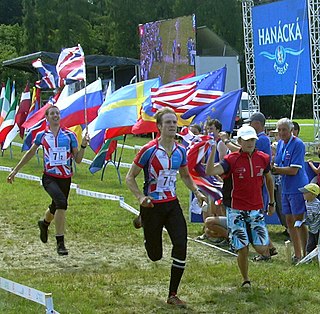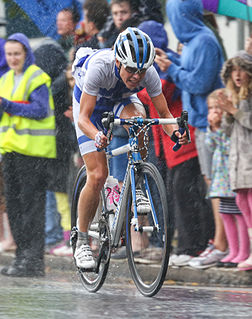
A triathlon is an endurance multisport race consisting of swimming, cycling, and running over various distances. Triathletes compete for fastest overall completion time, racing each segment sequentially with the time transitioning between the disciplines included. The word is of Greek origin, from τρεῖς or treis (three) and ἆθλος or athlos (competition).

A relay race is a racing competition where members of a team take turns completing parts of racecourse or performing a certain action. Relay races take the form of professional races and amateur games. Relay races are common in running, orienteering, swimming, cross-country skiing, biathlon, or ice skating. In the Olympic Games, there are several types of relay races that are part of track and field. Relay race, also called Relay, a track-and-field sport consisting of a set number of stages (legs), usually four, each leg run by a different member of a team. The runner finishing one leg is usually required to pass the next runner a stick-like object known as a "baton" while both are running in a marked exchange zone. In most relays, team members cover equal distances: Olympic events for both men and women are the 400-metre and 1,600-metre relays. Some non-Olympic relays are held at distances of 800 m, 3,200 m, and 6,000 m. In the less frequently run medley relays, however, the athletes cover different distances in a prescribed order—as in a sprint medley of 200, 200, 400, 800 metres or a distance medley of 1,200, 400, 800, 1,600 metres.

Road running is the sport of running on a measured course over an established road. This differs from track and field on a regular track and cross country running over natural terrain.

An ultramarathon, also called ultra distance or ultra running, is any footrace longer than the traditional marathon length of 42.195 kilometres. Various distances are raced competitively, from the shortest common ultramarathon of 50 kilometres (31 mi) to over 100 kilometres (62 mi). 50k and 100k are both World Athletics record distances, but some 100 miles (160 km) races are among the oldest and most prestigious events, especially in North America. Around 100 miles is typically the longest course distance raced in under 24 hours but there are also longer multi-day races of 200 miles (320 km) or more, sometimes raced in stages with breaks for sleep. While some ultras are road races, many take place on trails, leading to a large overlap with the sports of trail running and mountain running.

Trail running is a sport-activity which combines running, and, where there are steep gradients, hiking, that is run "on any unpaved surface". It is similar to both mountain and fell running. Mountain running may, however, include paved sections. Trail running normally takes place in warm climates, or on good paths, or tracks which are relatively easy to follow, and does not necessarily involve the significant amounts of ascent, or need for navigating skills, normal in fell running. Unlike road running and track running it generally takes place on hiking trails, often in mountainous terrain, where there can be much larger ascents and descents. It is difficult to definitively distinguish trail running from cross country running. In general, however, cross country is an IAAF-governed discipline that is typically raced over shorter distances.

Cyclo-cross is a form of bicycle racing. Races typically take place in the autumn and winter, and consist of many laps of a short course featuring pavement, wooded trails, grass, steep hills and obstacles requiring the rider to quickly dismount, carry the bike while navigating the obstruction and remount. Races for senior categories are generally between 40 minutes and an hour long, with the distance varying depending on the ground conditions. The sport is strongest in the traditional road cycling countries such as Belgium, France and the Netherlands.

Cycle sport is competitive physical activity using bicycles. There are several categories of bicycle racing including road bicycle racing, cyclo-cross, mountain bike racing, track cycling, BMX, and cycle speedway. Non-racing cycling sports include artistic cycling, cycle polo, freestyle BMX and mountain bike trials. The Union Cycliste Internationale (UCI) is the world governing body for cycling and international competitive cycling events. The International Human Powered Vehicle Association is the governing body for human-powered vehicles that imposes far fewer restrictions on their design than does the UCI. The UltraMarathon Cycling Association is the governing body for many ultra-distance cycling races.

A cyclosportive, or often simply sportive, is a short to long distance, organised, mass-participation cycling event, typically held annually. The Italian term Gran Fondo is commonly used for these events in the United States, Australia and some other English-speaking countries.

Jeremiah Bishop is a professional mountain bike racer from the United States. He competes in ultra-endurance mountain bike racing, mountain bike stage racing, and the Olympic-discipline event of cross-country cycling.

Mountain bike racing is the competitive cycle sport discipline of mountain biking held on off-road terrain. The Union Cycliste Internationale (UCI) recognised the discipline relatively late in 1990, when it sanctioned the world championships in Durango, Colorado. The first UCI Mountain Bike World Cup series took place in 1988. Its nine-race circuit covered two continents—Europe and North America—and was sponsored by Grundig. Cross-country racing was the only World Cup sport at this time. In 1993, a six-event downhill World Cup was introduced. In 1996, cross-country mountain biking events were added to the Olympic Games. In 2006, cross-country mountain biking events became part of the World Deaf Cycling Championships for the first time in San Francisco, USA.
The Mohican MTB 100 is an ultra-endurance 100 mile (161 km) mountain bike race held annually in early June in North Central Ohio. The course contains over 11,000 feet of climbing on single-track, double-track and dirt roads. This course is very scenic, almost entirely tree covered and more than 90% on dirt.

The Lumberjack 100 is an ultra-endurance mountain bike race held the 3rd Saturday in June at Michigan's Big M Cross Country Ski and Mountain Bike Trail in the Manistee National Forest. The race is a 100-mile mountain bike marathon and is part of the National Ultra Endurance Series. The race course consists of three 33.33 mile laps in the Udell Hills area and crosses the North Country National Scenic Trail twice per lap. The course contains over 8,000 feet of climbing and is 80% single track. Due to venue limitations, only 450 racers are allowed to participate.
David "Tinker" Juarez is an American former professional BMX and cross-country mountain bike racer. His prime competitive years in BMX were from 1978 to 1984 and in mountain bike racing 1986 to 2005. Since late 2005, he has competed as a Marathon mountain bike racer. In all three disciplines, he has won numerous national and international competitions. Most recently, Juarez finished third in the 2006 Race Across America Endurance bicycle race.

Cross-country (XC) cycling is a discipline of mountain biking. Cross-country cycling became an Olympic sport in 1996 and is the only form of mountain biking practiced at the Olympics.

Pia Ann-Katrine Sundstedt is a professional former cyclist, who competes in road bicycle racing and mountain bike racing, as well as cross-country skiing events. Sundstedt competed in the Summer Olympics for Finland. Having started in 2006, Sundstedt competes for Rocky Mountain/Business Objects mountain bike racing team.

The UCI world championships are annual competitions promoted by the Union Cycliste Internationale (UCI) to determine world champion cyclists. They are held in several different styles of racing, in a different country each year. Championship winners wear a white jersey with coloured bands around the chest for the following year. The similarity to the colours of a rainbow gives them the colloquial name of "the rainbow jersey." The first three individuals or teams in each championship win gold, silver and bronze medals. Former world champions are allowed to wear a trim to their collar and sleeves in the same pattern as the rainbow jersey.
The Leadville Trail 100 MTB is the second oldest of the well-known 100-mile (160 km) marathon mountain bike races held in the United States, the oldest being the Wilderness 101 in Central PA. The Leadville Trail 100 MTB was first run in 1994 and has become one of the best marketed, attended and known marathon events in mountain bike racing.
The Medoc Trail Marathon is a marathon, 42.195 kilometres (26.219 mi) in length, held each October at Medoc Mountain State Park in Hollister, North Carolina. The race is run on a ten mile loop trail, with the second and third laps being run over a shorter version of the loop. The race is run in conjunction with a 10-mile run.

Jaroslav Kulhavý, is a Czech mountain biker
The definition of ultra-distance cycling is far more vague than in ultra running or in ultra-triathlon. Any bike race or ride longer than a century ride, which is 100 miles (160 km), is sometimes considered to be ultra-distance cycling. However, such events are relatively common, so using a longer distance to define the category is more useful, such as any race or ride that is longer than 200 kilometres (120 mi), 300 kilometres (190 mi) or even a double century, 200 miles (320 km).















